Most viewed
- Page Path
-
- HOME
- BROWSE ARTICLES
- Most viewed
"Most viewed" Articles are from the articles published in 2022 during the last six month.
- Clinical Note
- Genetics and Metabolism
- Biallelic POLR3A variants cause Wiedemann-Rautenstrauch syndrome with atypical brain involvement (870 times)
- Byungseung Moon, Minhye Kim, Hye Jin Kim, Jae So Cho, Hey Joon Son, Byung Chan Lim, Ki Joong Kim, Jong Hee Chae, Soo Yeon Kim
- Clin Exp Pediatr. 2023;66(3):142-144. Published online December 30, 2022
-
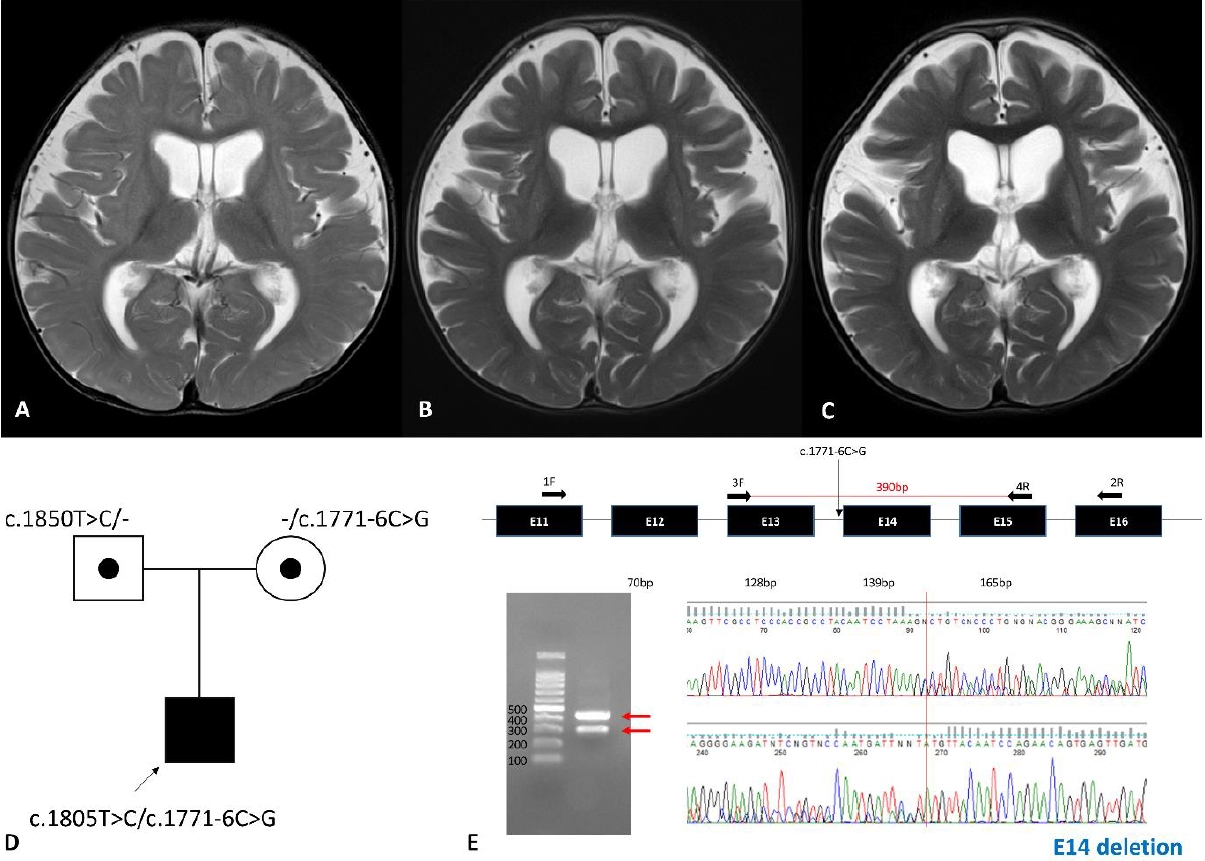
- Original Article
- Developmental and Behavioral Medicine
- Neonatal risk factors associated with attention-deficit/hyperactivity disorder: an umbrella review (867 times)
- Ensiyeh Jenabi, Erfan Ayubi, Sajjad Farashi, Saeid Bashirian, Fereshteh Mehri
- Clin Exp Pediatr. 2023;66(10):441-446. Published online July 14, 2023
-
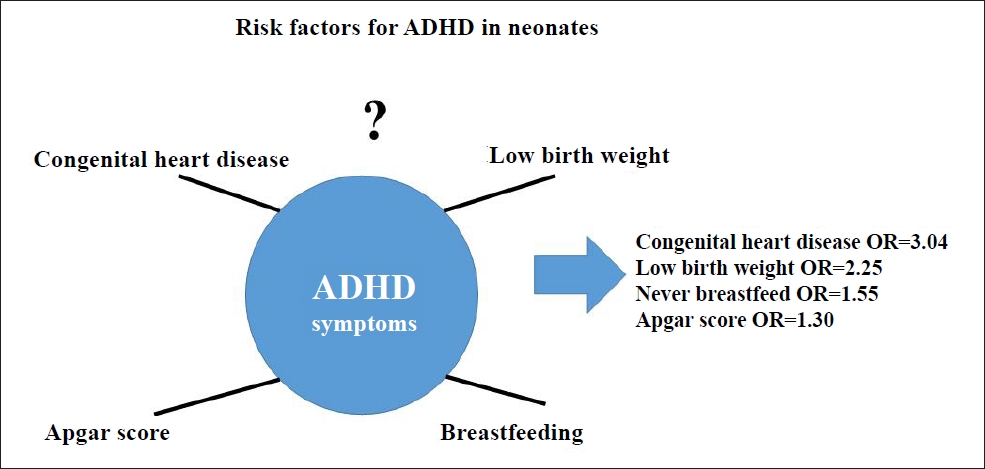
Question: The risk factors for attention deficit hyperactivity disorder (ADHD), such as breastfeeding, congenital heart disease, and low birth weight, in neonates are not well understood.
Finding: This umbrella review obtained significant effect sizes for ADHD for congenital heart disease (odds ratio [OR], 3.04), low birth weight (OR, 2.25), never breastfed (OR, 1.55), and Apgar score (OR, 1.30).
Meaning: Congenital heart disease, low birth weight, lack of breastfeeding, and Apgar scores were significant factors for ADHD.
- Cardiology
- Echocardiographic reference z scores of right ventricular dimension and systolic function of children aged 5–12 years (857 times)
- Alaba Busola Oladimeji, Moriam Omolola Lamina, Peter Odion Ubuane, Motunrayo Oluwabukola Adekunle, Omolara Adeolu Kehinde, Barakat Adeola Animasahun, Olisamedua FidelisNjokanma
- Clin Exp Pediatr. 2023;66(5):215-222. Published online April 18, 2023
-

Question: Z score reference values for right ventricular size and systolic function in children using echocardiography are available in several countries. Despite the high burden of diseases involving the right ventricle in Nigeria, these reference values have limited applicability.
Finding: The right ventricular sizes of Nigerian children differed from those published elsewhere.
Meaning: These reference values will aid the treatment, monitoring, and pre- and postintervention for Nigerian children.
- Editorial
- Gastroenterology
- Noninvasive and simple, but accurate? Meta-analysis of evidence-based point-of-care ultrasound for assessing dehydration in children (848 times)
- Jin-Hee Oh
- Clin Exp Pediatr. 2023;66(11):475-476. Published online July 11, 2023
-
· Point-of-care ultrasound imaging, including measurement of the inferior vena cava/aorta ratio, is powerful for evaluating the hemodynamic status of pediatric patients.
· Owing to the limited feasibility of randomized clinical trials and insufficient data in children, imaging tools require validation.
· Objective validity meta-analyses of imaging studies can affect clinical decision-making and serve as a cornerstone for evidence-based practice in pediatrics.
- Original Article
- Infection
- Seroprevalence of maternal peripartum human T-cell lymphotropic virus type-1 infection: a systematic review and meta-analysis of the Nigerian literature (824 times)
- Abdulrasheed Usman, Muhammad Hamis Musa, Bukhari Isah Shuaib, Olayemi Balogun, Mukhtar Adeiza
- Clin Exp Pediatr. 2023;66(7):307-316. Published online December 22, 2022
-
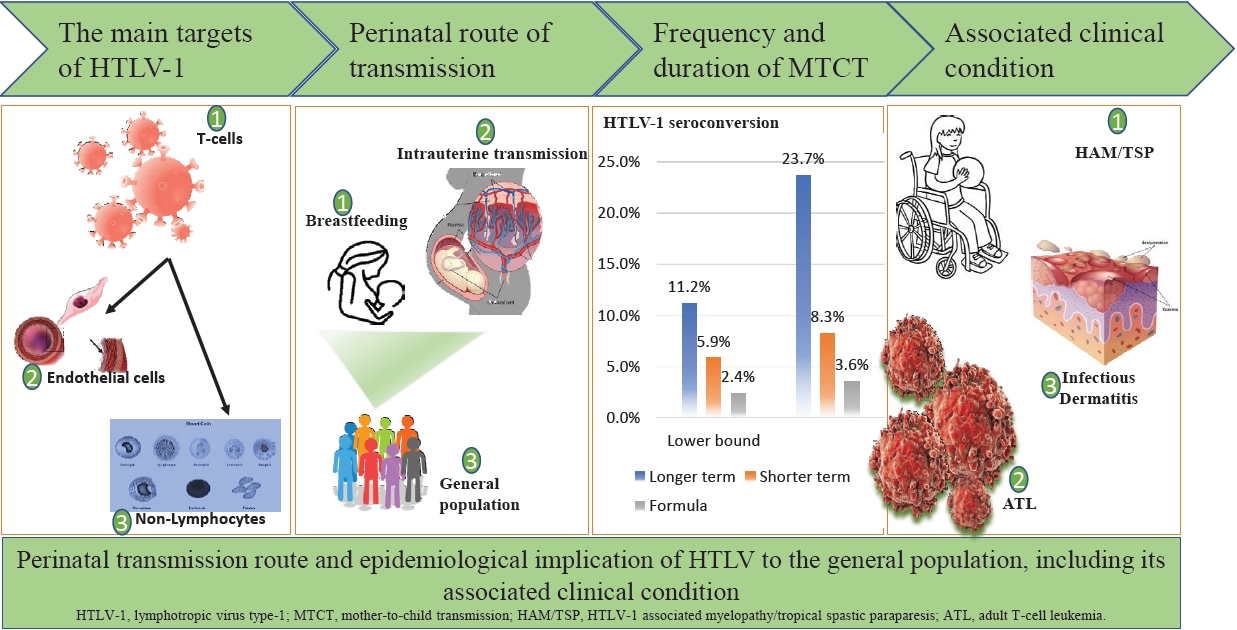
The peripartum period is an important transmission time for human T-cell lymphotropic virus-1 (HTLV-1) infection, mainly via breastfeeding and partly through the placental tissues of carrier mothers. Although most HTLV-1–infected individuals are asymptomatic, fetal and childhood infections often result in several diseases with disappointing treatment outcomes. An estimated HTLV-1 burden in Nigeria among perinatal women must be determined to enable rational planning of a comprehensive health care intervention.
- Gastroenterology
- Association between maternal weight gain during pregnancy and child’s body mass index at preschool age (823 times)
- Jeewon Shin, Yoowon Kwon, Ju Hee Kim, Su Jin Jeong
- Clin Exp Pediatr. 2023;66(2):76-81. Published online November 30, 2022
-
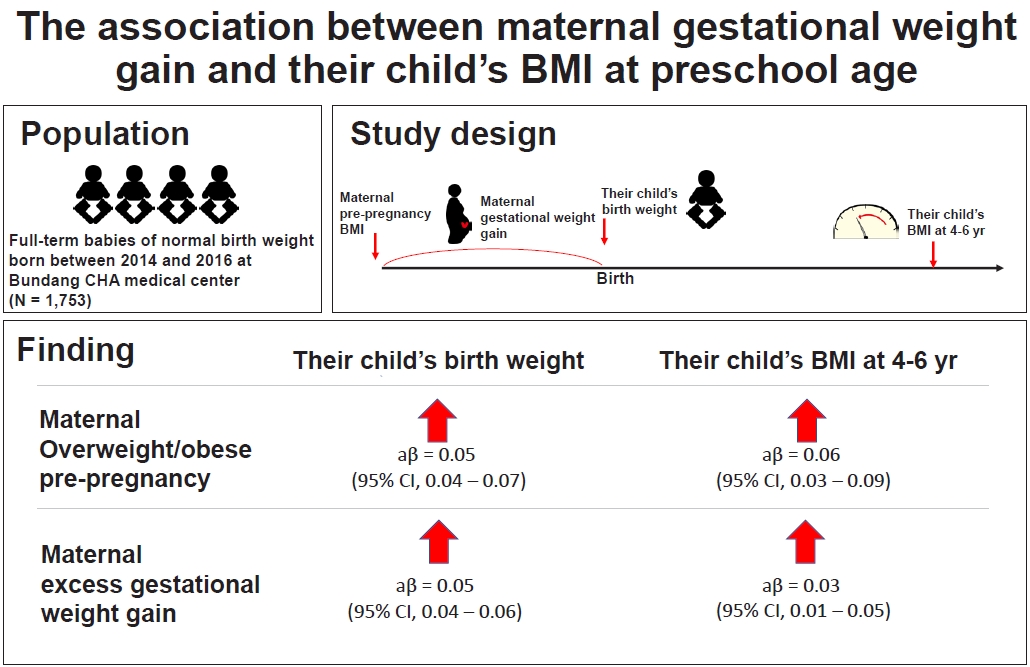
Question: What are the risk factors of newborn birth weight? Does gestational weight gain and prepregnancy body mass index affect childhood weight?
Finding: Excess maternal weight gain increases the risk of overweight/obesity, newborn birth weight, and child body mass index at 4–6 years.
Meaning: Maternal weight control before and during pregnancy should be well controlled.
- Letter to the Editor
- Oncology
- Retrospective review of severe acute respiratory syndrome coronavirus-2 infection in children with acute leukemia from a tertiary care hospital in Northern India (822 times)
- Suhail Chhabra, Aditya Dabas, Richa Mittal, Neha Goel, Ritabrata Roy Chowdhary, Satyendra Batra, Amitabh Singh, Rani Gera
- Clin Exp Pediatr. 2022;65(3):150-151. Published online November 26, 2021
-
- Endocrinology
- Accuracy of predicted adult height using the Greulich-Pyle method and artificial intelligence medical device (821 times)
- Dongho Cho, Yun Sun Choi, Hayun Oh, Young min Ahn, Ji-Young Seo
- Clin Exp Pediatr. 2023;66(3):145-147. Published online January 25, 2023
-
- Review Article
- Cardiology
- Environmental changes surrounding congenital heart disease (815 times)
- Eun-Young Choi
- Clin Exp Pediatr. 2023;66(8):332-338. Published online January 2, 2023
-
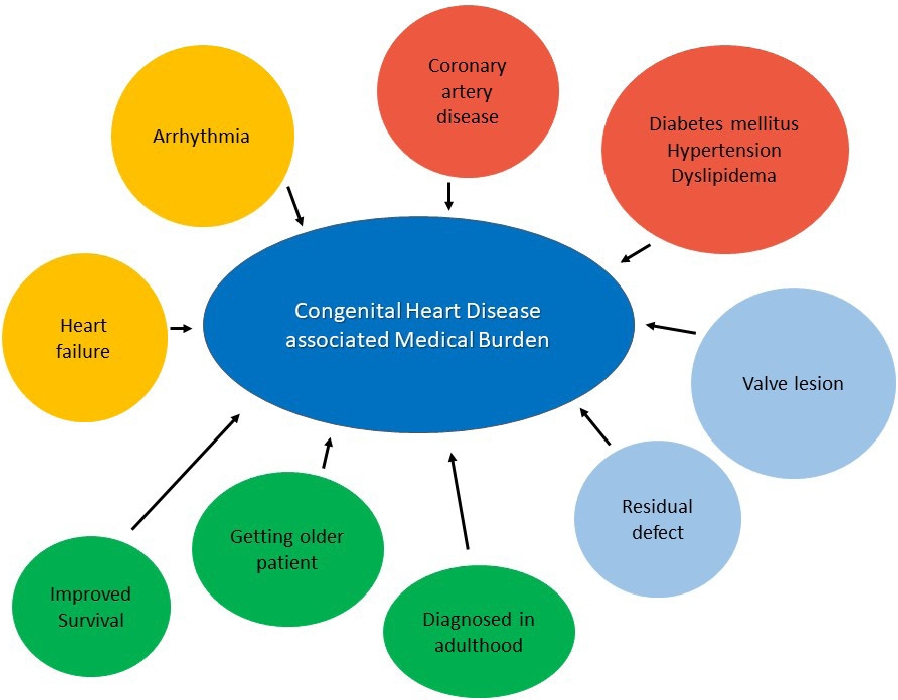
· As the number of patients with congenital heart disease increases, the medical burden increases.
· Various fusion imaging techniques using percutaneous procedures have been introduced.
· With advances in technology, convenient ambulatory devices have been introduced.
· A well-organized team approach is required to resolve advanced heart failure in patients with congenital heart disease.
- Editorial
- Immunology
- Systemic autoinflammatory disorders: autoinflammatory and autoimmune disorders (812 times)
- Young Dae Kim
- Clin Exp Pediatr. 2023;66(10):439-440. Published online July 4, 2023
-
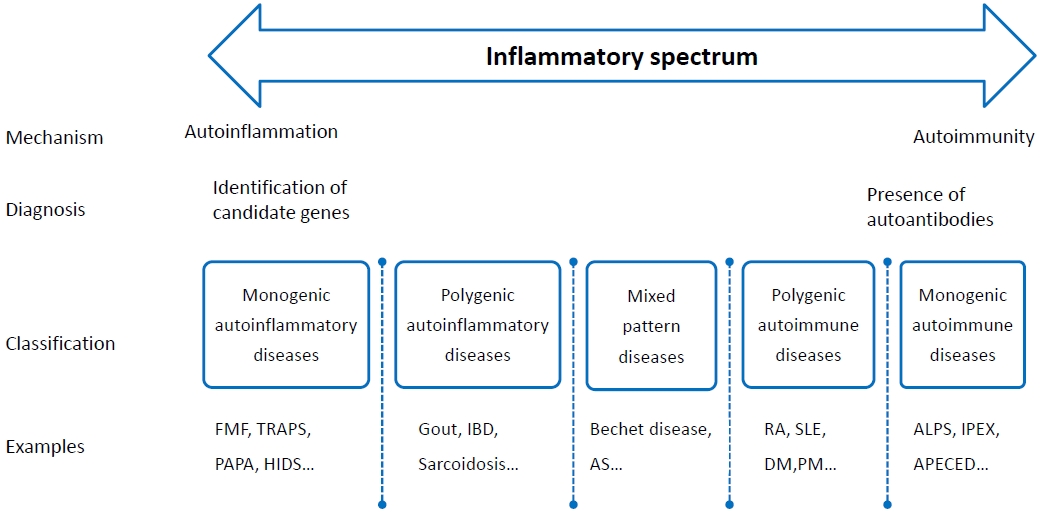
· Systemic autoinflammatory disorders (SAIDs) typically have an early onset in life, and may have close relatives may have similar disease.
· SAIDs should be suspected in any patient, especially children, who experience persistent or recurrent inflammatory episodes that fail to fit the pattern of other established diseases.
· Advancements in the understanding of autoinflammation will provide novel diagnostic and therapeutic options for SAIDs patients.
- Pulmonology
- Wheezing in infants and preschoolers: phenotypes and treatment options (804 times)
- Jung Yeon Shim
- Clin Exp Pediatr. 2023;66(1):26-27. Published online December 6, 2022
-
· Knowing who will develop into asthma or who will not is important to impose proper treatment and early intervention in a child with the first episode of wheezing.
· Phenotypes of severe bronchiolitis in less than 2-year-old children with first episode of wheezing were suggested for different treatment options
· RV-induced and/or atopy-associated severe wheezing in preschool children may benefit from early intervention of asthma treatment.
- Letter to the Editor
- Cardiology
- Early prophylaxis of cardiomyopathy with beta-blockers and angiotensin receptor blockers in patients with Duchenne muscular dystrophy (797 times)
- Heirim Lee, Jinyoung Song, I-Seok Kang, June Huh, Jin A Yoon, Yong Beom Shin
- Clin Exp Pediatr. 2022;65(10):507-509. Published online August 22, 2022
-
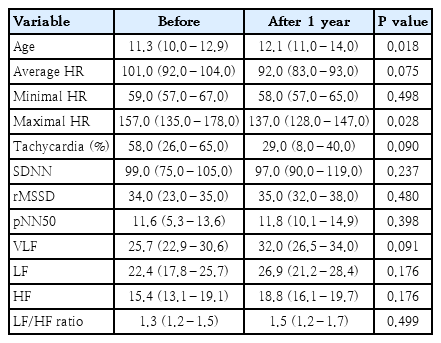
- Review Article
- Neonatology (Perinatology)
- Growth patterns of preterm infants in Korea (795 times)
- Joohee Lim, So Jin Yoon, Soon Min Lee
- Clin Exp Pediatr. 2022;65(1):1-9. Published online July 8, 2021
-
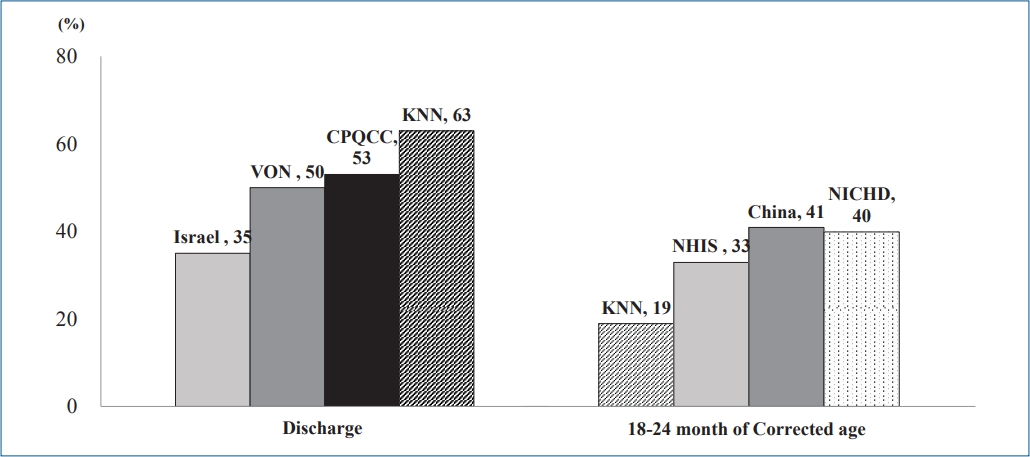
∙ The growth of preterm infants is a main focus of neonatology.
∙ Preterm infants in Korea, especially those with a very low birth weight, achieve retarded growth.
∙ Careful growth monitoring and early intervention will contribute to better development outcomes and quality of life for preterm infants and improve public health.
- Original Article
- Developmental and Behavioral Medicine
- Parenting stress and interactive engagement behaviors in children with developmental delay (783 times)
- Jung Sook Yeom, Rock Bum Kim, Jae Young Cho, Ji Sook Park, Eun Sil Park, Ji-Hyun Seo, Jae-Young Lim, Hyang-Ok Woo
- Clin Exp Pediatr. 2023;66(6):252-261. Published online May 19, 2023
-
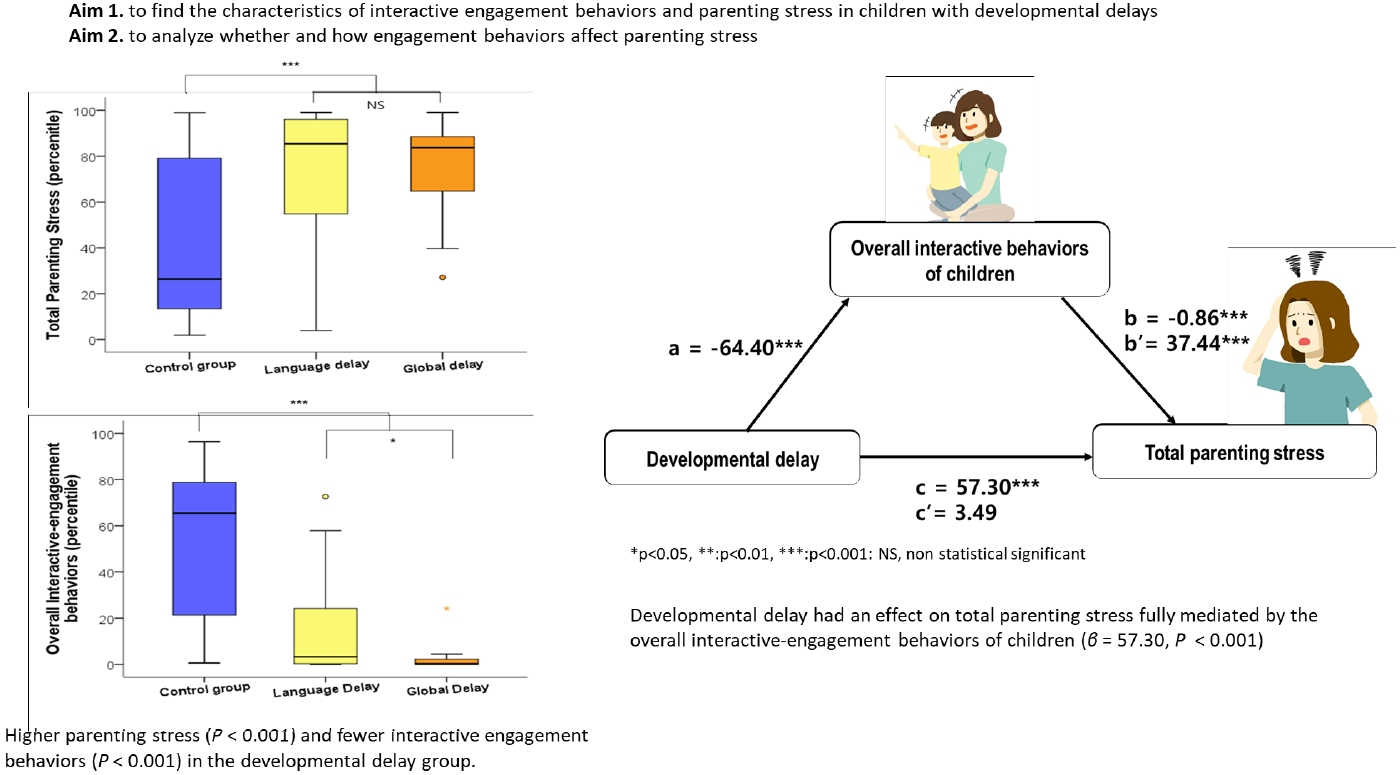
· Question: What level of parenting stress is experienced by parents of children with developmental delays (DDs) without autism spectrum disorder, and what factors contribute to it?
· Findings: Parents of children with DDs experienced high parenting stress that were significantly mediated by their children’s low interactive behaviors.
· Meaning: The interactive behaviors of children with DDs mediate parenting stress.
- Perspective
- Infection
- Statement on healthcare system preparedness in response to COVID-19 Omicron subvariants BA.4 and BA.5 surge in Korea from the Korean Pediatric Society and Korean Society of Pediatric Infectious Diseases (769 times)
- Eun Young Cho, Dong Hyun Kim, Soo-Han Choi, Ki Wook Yun, Jong Gyun Ahn, Hye-Kyung Cho, Hyunju Lee, Jina Lee, Taek-Jin Lee, Byung-Wook Eun, Jin Lee, Dae Sun Jo, Yun-Kyung Kim, Yae-Jean Kim; Committee on Infectious Diseases of the Korean Pediatric Society
- Clin Exp Pediatr. 2022;65(11):510-511. Published online September 23, 2022
-
In order to respond to the recent surge in coronavirus disease 2019 (COVID-19) cases and the continuously changing epidemiology of COVID-19, a sustainable and flexible pediatric healthcare system must be prepared considering the specificity of pediatric care. We demand a more proactive response from the health authorities to check the current state of pediatric COVID-19 patient care and to ensure that pediatric patients receive appropriate and timely management.
- Editorial
- Infection
- Impact and role of vitamins as immunonutrition in children during COVID-19 pandemic (764 times)
- Yoo Min Lee
- Clin Exp Pediatr. 2023;66(5):212-214. Published online April 18, 2023
-

· Vitamins have effector mechanisms in the innate and adaptive immune systems and potential roles in preventing and reducing the severity of coronavirus disease 2019 (COVID-19).
· Vitamins may be immunonutrients in the treatment of COVID-19 infections and prevention of patient deterioration due to critical illness, thus demonstrating the significance of a nutritious, well-balanced diet.
- Review Article
- General Pediatrics
- Motor performance of children with attention deficit hyperactivity disorder: focus on the Bruininks-Oseretsky Test of Motor Proficiency (754 times)
- Khushboo Prashant Adhvaryu, Suruliraj Karthikbabu, Pratiksha Tilak Rao
- Clin Exp Pediatr. 2022;65(11):512-520. Published online February 17, 2022
-
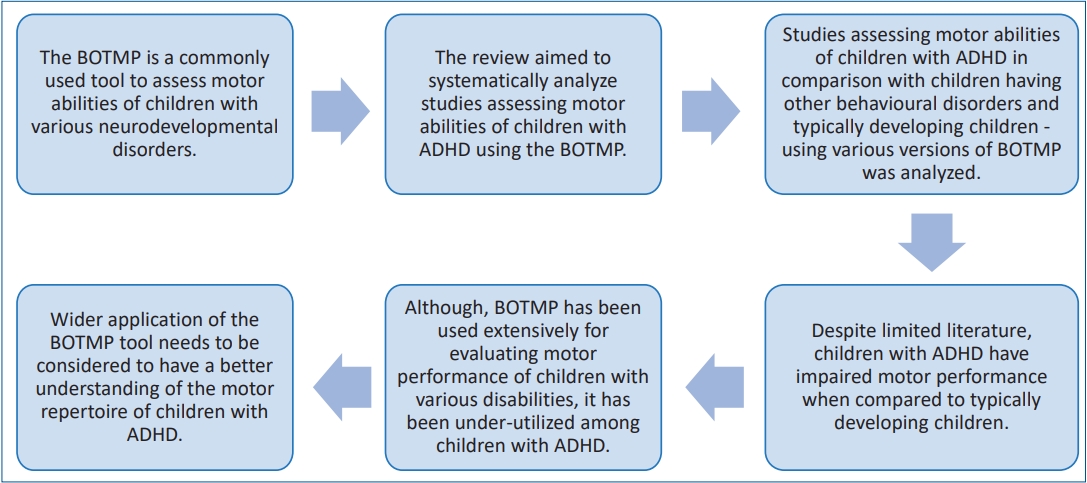
· Children with attention deficit hyperactivity disorder (ADHD) tend to have impaired motor performance that may affect their growth and development.
· Although widely used among children with developmental disorders, the Bruininks-Oseretsky Test of Motor Proficiency (BOTMP) is used sparsely among children with ADHD.
· Assessment by the BOTMP increases our understanding of the motor repertoire of children with ADHD.
· Wider usage of the BOTMP will enable more comprehensive planning of rehabilitation goals to enhance the motor abilities of children with ADHD.
- Clinical Note
- Endocrinology
- Graves’ disease: an uncommon cause of late sequelae following DRESS (drug reaction with eosinophilia and systemic symptoms) (736 times)
- Therdpong Tempark, Amatanun Tangthanapalakul, Tawatchai Deekajorndech, Susheera Chatproedprai, Vichit Supornsilchai, Siriwan Wananukul
- Clin Exp Pediatr. 2022;65(12):602-604. Published online June 22, 2022
-
- Editorial
- Emergency Medicine
- Current diagnosis and image-guided reduction for intussusception in children: teamwork approach (733 times)
- Ji-Hyun Seo
- Clin Exp Pediatr. 2023;66(2):66-67. Published online September 1, 2022
-
· The successful and safe enema reduction of intussusception depends primarily on the experience and preference of the radiologists and the availability of resources.
· The establishment of a standardized manual or protocol for reduction and pre-reduction treatment of intussusception, along with the collaboration of pediatricians, radiologists, and surgeons, is expected to improve the treatment success rate.
- Original Article
- Neonatology (Perinatology)
- Mediation effect of cord blood cortisol levels between maternal prepregnancy body mass index and birth weight: a hospital-based cross-sectional study (728 times)
- Nisanth Selvam, Jayashree K, Prasanna Mithra
- Clin Exp Pediatr. 2022;65(10):500-506. Published online July 29, 2022
-

Question: What is the association between cord blood cortisol and maternal weight, birth weight, and cord blood lipid profile?
Finding: Cord blood cortisol levels did not influence the relationship between maternal weight changes or birth weight. Maternal weight changes, birth weight, and cortisol levels altered the cord blood lipid profile.
Meaning: Our findings may aid United Nations Sustainable Development Goal 3 (Good Health and Well-Being) achievement by 2030.
- Editorial
- Infection
- COVID-19 infection and vaccination among children (722 times)
- Amnuay Kleebayoon, Viroj Wiwanitkit
- Clin Exp Pediatr. 2023;66(12):531-532. Published online August 30, 2023
-
· Coronavirus disease 2019 (OVID-19) infection and immunization have been linked with kidney problems; however, causality has not been proven.
· Concern about confounders is usually needed.
· Correspondence about a published article on the COVID-19 vaccine
- Original Article
- Emergency Medicine
- Nonfatal injuries in Korean children and adolescents, 2007–2018 (718 times)
- Gyu Min Yeon, Yoo Rha Hong, Seom Gim Kong
- Clin Exp Pediatr. 2022;65(4):194-200. Published online September 9, 2021
-
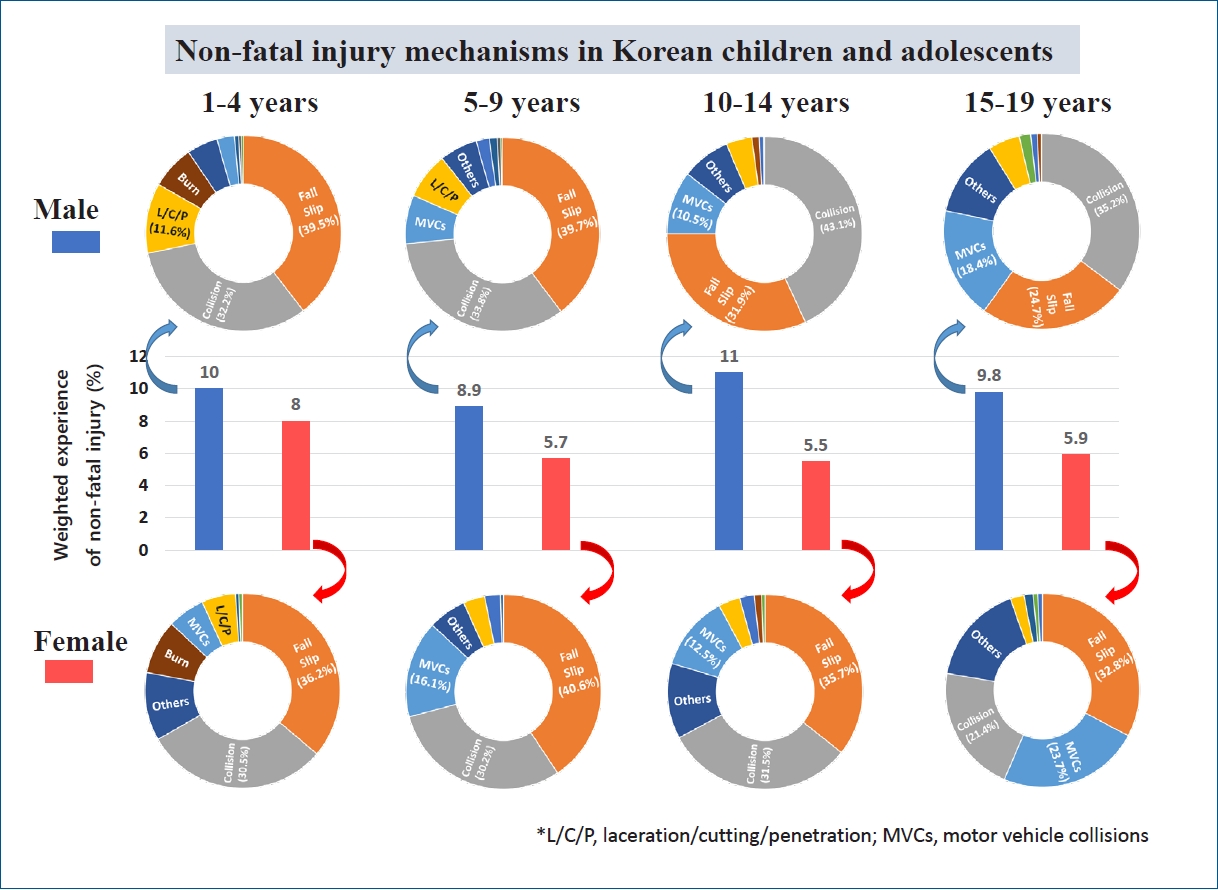
Question: How many children and adolescents have experienced nonfatal injuries in the previous year?
Finding: Among Korean children and adolescents, 8.1% experienced at least one injury per year. We found no significant change in the incidence of injuries over the previous 12 years.
Meaning: The incidence of injuries is higher than this estimation; therefore, more attention and effort are needed to prevent injuries among children and adolescents.
- Editorial
- Neurology
- Lumbar puncture or not: when does febrile seizure require a neurodiagnostic evaluation? (695 times)
- Seung Soo Kim
- Clin Exp Pediatr. 2023;66(2):68-69. Published online December 9, 2022
-
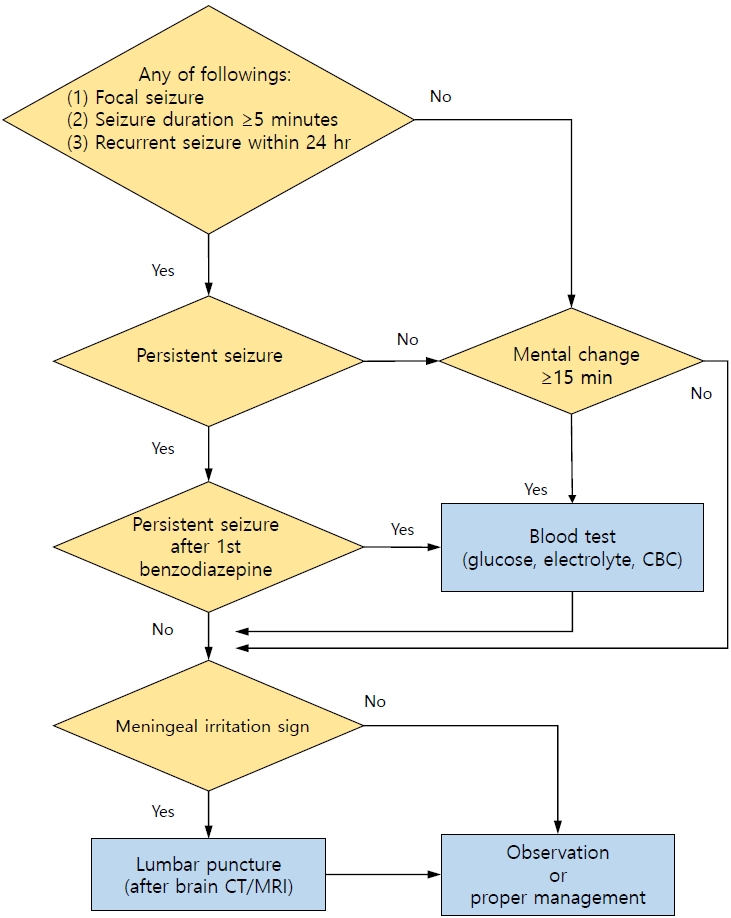
· A neurodiagnostic evaluation (lumbar puncture, blood tests, electroencephalography, and neuroimaging) is not indicated in most patients with simple febrile seizures.
· A lumbar puncture is indicated when a central nervous system infection is suspected in any patient with febrile seizures.
· Blood tests (glucose, electrolytes, and complete blood count) are indicated in patients with persistent seizure after benzodiazepine treatment, prolonged loss of consciousness, poor general condition, or signs of dehydration.
- Letter to the Editor
- Developmental and Behavioral Medicine
- The influence of parental eating behaviors, child-feeding practices, and infants’ temperaments upon infants’ eating behaviors (692 times)
- Goh Woon Lim, Kyoung Min Shin
- Clin Exp Pediatr. 2022;65(9):466-468. Published online June 27, 2022
-

- Retraction Notice
- Coronavirus disease 2019 in a 2-month-old male infant: a case report from Iran (690 times)
- Hosein Heydari, Seyed Kamal Eshagh Hossaini, Ahmad Hormati, Mahboubeh Afifian, Sajjad Ahmadpour
- Clin Exp Pediatr. 2022;65(8):417-417. Published online July 19, 2022
-
- Review Article
- Allergy
- Management of patients with allergic diseases in the era of COVID-19 (684 times)
- Eun Lee
- Clin Exp Pediatr. 2022;65(11):529-535. Published online September 23, 2022
-
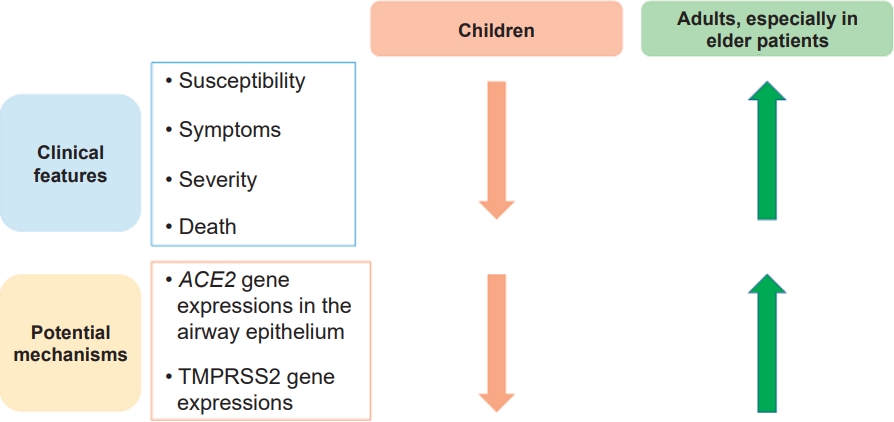
In the early days of the coronavirus disease 2019 (COVID-19) pandemic, allergic diseases, especially asthma, were considered to be risk factors for severe COVID-19 infection, hospitalization, and death. These concerns stemmed from the idea that individuals with allergic diseases are generally more susceptible to respiratory virus infections, which are major causes of exacerbation of allergic diseases. However, epidemiologic data with...
- Original Article
- Gastroenterology
- Ability of polymicrobial probiotic and mono-strain probiotic to reduce functional abdominal pain in children: a randomized clinical trial (678 times)
- Seyed Sajad Jafari, Seyed Mojtaba Hashemi, Bahman Sadeghi, Amir Almasi-Hashiani
- Clin Exp Pediatr. 2022;65(12):589-594. Published online October 31, 2022
-
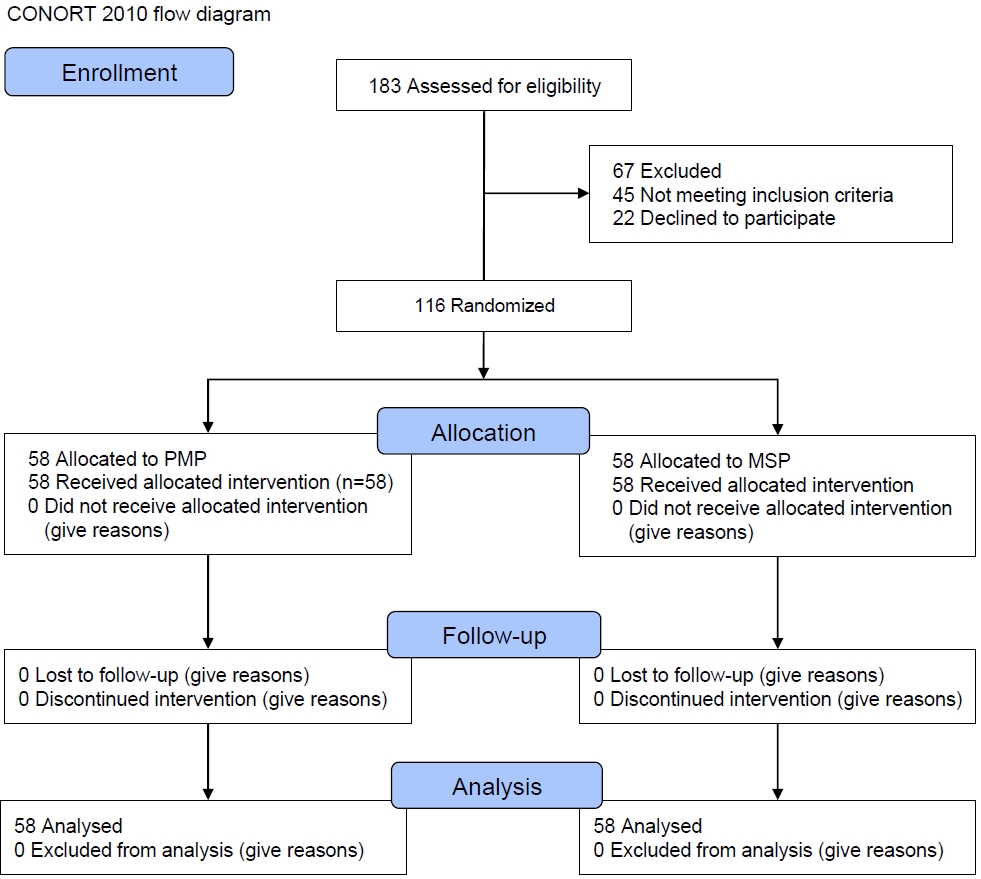
· This study compared the ability of 2 probiotics to reduce and improve functional abdominal pain (FAP) in children.
· In the polymicrobial probiotic (PMP) group, 10.34% of children reported no pain; in the mono-strain probiotic (MSP) group, all patients reported low-degree pain. The mean pain score decreased significantly over time in both groups.
· The use of both PMP and MSP is recommended to reduce pain in patients with FAP.
- Hematology
- Effect of cyclic pamidronate administration on osteoporosis in children with β-thalassemia major: a single-center study (670 times)
- Mahmoud A. El-Hawy, Nagwan Y. Saleh
- Clin Exp Pediatr. 2022;65(8):405-409. Published online June 7, 2022
-
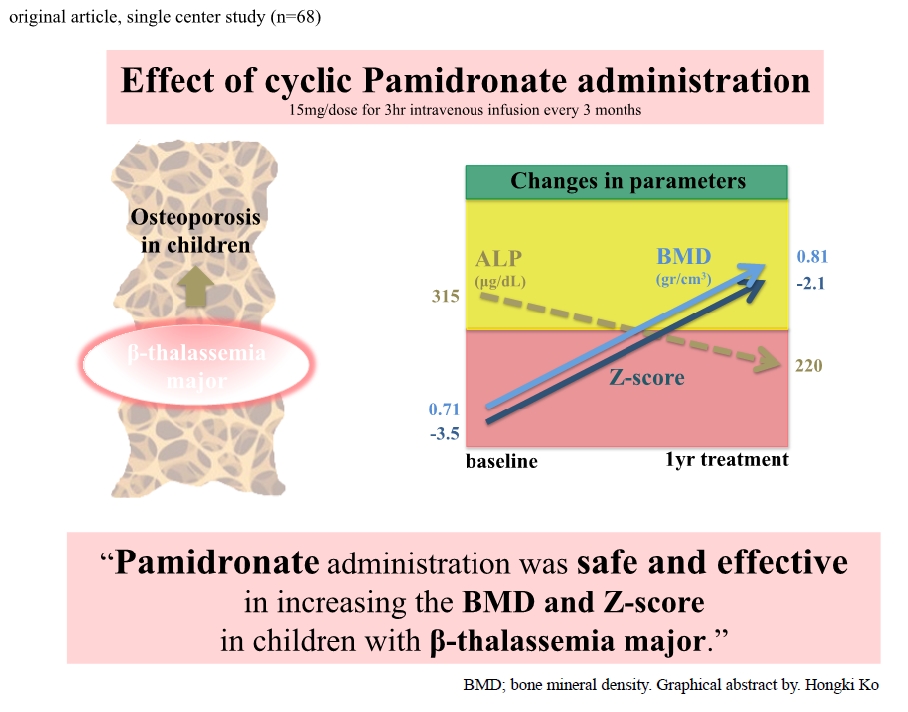
Question: What is the effect of cyclic pamidronate administration on osteoporosis in children with β-thalassemia major?
Finding: The dual-energy x-ray absorptiometry scan findings of children with β-thalassemia major and osteoporosis were improved after pamidronate administration.
Meaning: Cyclic pamidronate effectively treated osteoporosis in children with β-thalassemia major.
- Editorial
- Cardiology
- Coronavirus disease 2019 and mRNA vaccines: what’s next – miRNA? (666 times)
- Joon Kee Lee, Heon-Seok Han
- Clin Exp Pediatr. 2022;65(6):302-303. Published online March 28, 2022
-
MicroRNAs (miRNAs) are small single-stranded noncoding RNA molecules that function in RNA silencing and the posttranscriptional regulation of gene expression. The potential role of miRNAs as biomarkers of myocarditis is promising, and miRNAs are expected to be utilized in various clinical fields in the future.
- Gastroenterology
- Gut microbiota’s impact on obesity (660 times)
- Sujin Jeong
- Clin Exp Pediatr. 2023;66(7):294-295. Published online June 14, 2023
-

· An imbalance of the gut microbiota with a relative increase in Firmicutes versus Bacteroidetes is associated with the pathogenesis of obesity.
· Dysbiosis is associated with microbial genes associated with short-chain fatty acids (SCFA) production and increased colonic SCFA levels. SCFAs have also been shown to regulate appetite and satiety hormones, which can affect food intake and energy balance.
· A dietary high-fat intake is reportedly associated with increased plasma lipopolysaccharide. Altered Toll-like receptor-4 signaling leads to propagating the cascade of further inflammation and promoting insulin resistance.
-

-
-

-

-
Impact Factor4.2
-
6.52022CiteScore92nd percentilePowered by







